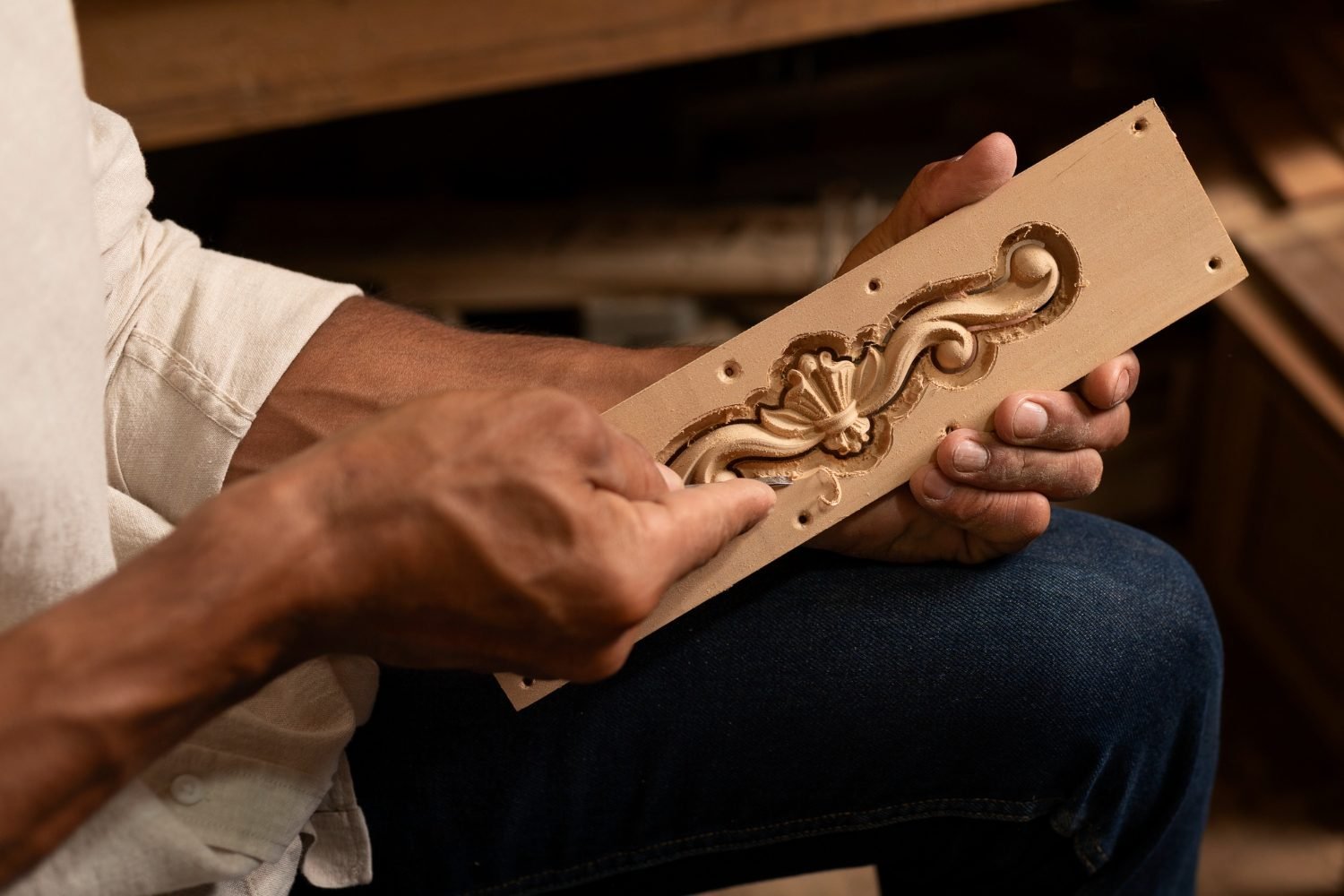Wooden craftsmanship is a testament to humanity’s ability to merge artistic vision with the natural world’s raw materials. For centuries, skilled artisans have transformed wood into breathtaking masterpieces that serve functional, decorative, and cultural purposes. This art form, which seamlessly combines skill and nature, has stood the test of time, symbolizing creativity, sustainability, and the enduring charm of handmade goods.
This article delves into the essence of wooden craftsmanship, exploring its history, techniques, significance, and modern relevance.
The Legacy of Wooden Craftsmanship
The history of wooden craftsmanship dates back to the earliest civilizations when humans first used wood for survival—building shelters, tools, and weapons. Over time, the functional use of wood evolved into an art form, with artisans honing their skills to create intricate designs that reflected their cultures and lifestyles.
Historical Highlights
- Ancient Egypt: Wood was a preferred material for furniture, coffins, and decorative items, often adorned with inlays of gold and ivory.
- India: Renowned for its temple carvings, wooden toys, and ornamental architecture, India remains a global hub for wooden artistry.
- Europe: During the Renaissance, wood became central to ornate furniture and architectural elements, blending form with function.
- Japan: Japanese craftsmen perfected woodworking techniques like Kumiko (wooden latticework) and Shou Sugi Ban (wood preservation), showcasing simplicity and precision.
The versatility and beauty of wood have made it a cornerstone of cultural expression across the globe.
The Connection Between Nature and Art
Wooden craftsmanship begins with nature. Each tree’s grain, color, and texture inspire the artisan’s creative journey. This harmonious relationship between the artist and the material is what makes wooden craftsmanship so unique.
Why Wood is Ideal for Artisanal Creations
- Natural Beauty: The organic patterns in wood make each piece distinctive and impossible to replicate.
- Versatility: Wood can be carved, turned, polished, or combined with other materials to create a wide range of products.
- Sustainability: When sourced responsibly, wood is an eco-friendly medium that supports sustainable practices.
- Durability: Properly treated wooden items are timeless, becoming heirlooms passed down through generations.
Wood bridges the gap between nature’s imperfection and human precision, making every piece a harmonious blend of the two.
Mastering the Art of Wooden Craftsmanship
Wooden craftsmanship is a labor-intensive process that demands a deep understanding of the material, patience, and years of practice. From the selection of wood to the finishing touches, every stage requires skill and precision.
Key Techniques in Wooden Craftsmanship
- Carving: Using chisels and gouges, artisans shape wood into intricate patterns or lifelike sculptures.
- Lathe Work: Woodturning involves spinning the wood on a lathe and shaping it into symmetrical designs like bowls and spindles.
- Joinery: Creating strong, seamless joints without nails or screws showcases the craftsman’s engineering prowess.
- Inlay Work: Embedding other materials like metal, ivory, or contrasting wood into a wooden surface enhances its decorative appeal.
- Finishing: Sanding, staining, and polishing bring out the natural grain and protect the piece from wear and tear.
Each technique reflects the artisan’s dedication to perfecting their craft and their ability to adapt their skills to the unique properties of the wood.
The Symbolism and Significance of Wooden Craftsmanship
Wooden craftsmanship is more than just a form of artistic expression; it is deeply rooted in cultural, spiritual, and symbolic traditions. Across cultures, wooden artifacts have served as symbols of status, spiritual connection, and craftsmanship.
Cultural Significance
- India: Intricate wooden idols and furniture often depict religious and cultural stories, symbolizing divinity and tradition.
- Africa: Hand-carved masks and figurines represent ancestral spirits and tribal history.
- Scandinavia: Clean-lined wooden furniture reflects the region’s appreciation for simplicity and functionality.
- Japan: Wooden craftsmanship embodies the philosophy of Wabi-Sabi, celebrating imperfection and the beauty of natural materials.
These pieces serve as a bridge between past and present, preserving traditions while inspiring contemporary designs.
The Modern Relevance of Wooden Craftsmanship
In an era dominated by industrialization and mass production, wooden craftsmanship has experienced a revival. Consumers are increasingly drawn to handmade products that tell a story, celebrate individuality, and promote sustainability.
Why Wooden Craftsmanship Thrives Today
- Uniqueness: No two handcrafted wooden items are alike, giving them a sense of exclusivity.
- Eco-Friendly Appeal: Wooden products, especially those made from reclaimed or sustainably sourced wood, align with environmentally conscious values.
- Versatility: Wooden craftsmanship caters to a wide range of tastes, from rustic decor to modern minimalist designs.
- Support for Artisans: Purchasing handcrafted wooden items directly supports skilled artisans and their communities.
The growing demand for authenticity and sustainability ensures that wooden craftsmanship remains relevant and valued in the modern marketplace.
Iconic Wooden Craftsmanship Around the World
Here are some notable examples of wooden craftsmanship that highlight its global appeal:
- Teakwood Furniture (India): Durable and intricately designed, these pieces are a staple in Indian homes.
- Kokeshi Dolls (Japan): Traditional wooden dolls with simple yet elegant designs symbolize Japanese culture.
- African Sculptures: Hand-carved statues and masks reflect Africa’s rich heritage and artistic traditions.
- Norwegian Stave Churches: These wooden architectural marvels are examples of medieval craftsmanship.
- American Shaker Furniture: Known for its simplicity and functionality, Shaker furniture remains timeless.
These creations exemplify how wooden craftsmanship transcends borders and cultures, showcasing universal artistry.
Preserving the Craft for Future Generations
The survival of wooden craftsmanship depends on passing down knowledge and skills to future generations. Efforts to preserve this art form include:
- Workshops and Apprenticeships: Training young artisans ensures the continuity of traditional techniques.
- Artisan Collectives: Collaborative efforts help craftsmen reach broader audiences and gain fair compensation for their work.
- Eco-Friendly Practices: Sustainable sourcing of wood and eco-conscious production methods protect the environment and promote the craft.
By investing in and supporting wooden craftsmanship, we can ensure its legacy endures for generations to come.
Conclusion
Wooden craftsmanship is the perfect blend of skill and nature, creating timeless pieces that resonate with beauty, functionality, and sustainability. It embodies the essence of handmade art, connecting us to traditions, cultures, and the natural world.
As we navigate a fast-paced, industrialized world, wooden craftsmanship offers a refreshing reminder of the value of patience, creativity, and the beauty of imperfection. Supporting this craft not only preserves a rich heritage but also fosters a deeper appreciation for the artistry that transforms nature’s gifts into works of enduring elegance.
Whether you’re looking for a functional item or a decorative masterpiece, wooden craftsmanship offers something truly unique—an opportunity to bring a piece of nature’s artistry into your life.








































































































































































































































































































































































































































































































































































































































































































































































































































































































































































































































